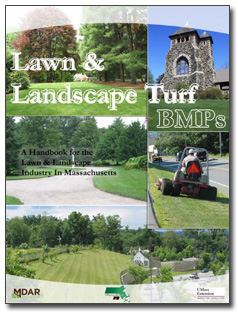Best Management Practices
Overview
UMass Extension has recently developed a comprehensive manual of Best Management Practices (BMPs) for lawn and landscape turf, which is available for download by clicking the link to the right. The guide is a detailed collection of economically feasible methods that conserve water and other natural resources, protect environmental quality and contribute to sustainability.
The BMPs detailed in this document are agronomically sound, environmentally sensible strategies and techniques designed with the following objectives:
- to protect the environment
- to use resources in the most efficient manner possible
- to protect human health
- to enhance the positive benefits of turf in varied landscapes and uses
- to produce a functional turf
- to protect the value of properties
- to enhance the economic viability of businesses and communities
Lawn & Landscape Turf: A Key Resource
Residential and commercial lawns and utility-type turf comprise a significant portion of the the landscape in Massachusetts and beyond. These lawns may be at private residences, at business establishments, in industrial developments, on municipal properties, in parks, on public or private school grounds, and along roadsides and other utility areas. Lawns and similar turf areas are key resources, as they contribute to open space, provide recreation, add value to properties, and help to protect the environment. Properly maintained turf provides many functional, recreational, and ornamental benefits, which are summarized below.
Benefits of turf:
| Functional | Recreational | Ornamental | |
|---|---|---|---|
|
|
|
|
| Adapted from J. B. Beard and R. L. Green, 1994, from The Journal of Environmental Quality, The Role of Turfgrasses in Environmental Protection and Their Benefits to Humans. | |||
BMPs for Lawn & Landscape Turf
This BMP guide is intended for use in the management of lawn and landscape turf. While many of the practices delineated can be applied to the management of sports turf and other more intensively used turf, it is not the intent of this document to provide the more specialized BMPs that such intensive management systems require.
These BMPs are designed to be used in a wide range of lawn and landscape management situations. Not every BMP will apply to every site. Activities and practices may vary depending on management objectives and site parameters. In addition, there may be a specific practice or practices appropriate for an unusual site that does not appear in this
document.
When instituting a management program based on BMPs, the turf manager must first determine the desired functional quality of the lawn and the management level and resources necessary to achieve it. Various factors will need to be considered including site parameters, level and intent of use, potential for pest infestation, pest action level, and environmental sensitivity of the site.
BMPs for maintenance of lawn and landscape turf areas are most effectively implemented by an educated and experienced turf manager, but can also serve as guidelines for less experienced turf managers and others caring for lawn and landscape turf.
Integrated Pest Management
The BMPs in this document are based on the scientific principles and practices of integrated pest management (IPM). IPM is a systems approach that should form the foundation of any type of sound turf management program. This holds true whether the materials being used are organic, organic-based or synthetic. The components of IPM for lawn and landscape turf are detailed below and are described in more detail in pertinent sections of the document.
What is IPM? - Integrated Pest Management (IPM) is a systematic approach to problem solving and decision making in turf management. In practicing IPM, the turf manager utilizes information about turf, pests, and environmental conditions in combination with proper cultural practices. Pest populations and possible impacts are monitored in accordance with a pre-determined management plan. Should monitoring indicate that action is justified, appropriate pest control measures are taken to prevent or control unacceptable turf damage. A sound IPM program has the potential to reduce reliance on pesticides because applications are made only when all other options to maintain the quality and integrity of the turf have been exhausted.
The key components of an IPM system for turf can be tailored to fit most management situations. The steps in developing a complete IPM program are as follows:
- Assess site conditions and history
- Determine client or customer expectations
- Determine pest action levels
- Establish a monitoring (scouting) program
- Identify the pest/problem
- Implement a management decision
- Keep accurate records and evaluate program
- Communicate
